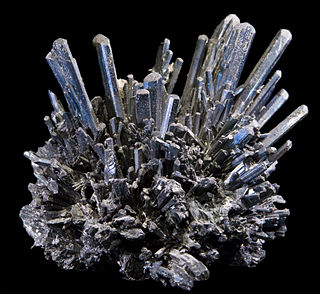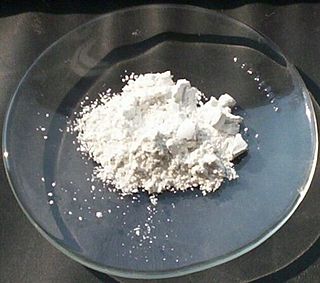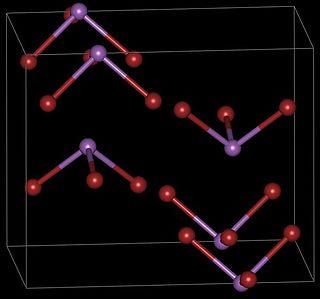This page is based on this
Wikipedia article Text is available under the
CC BY-SA 4.0 license; additional terms may apply.
Images, videos and audio are available under their respective licenses.

Stibnite, sometimes called antimonite, is a sulfide mineral with the formula Sb2S3. This soft grey material crystallizes in an orthorhombic space group. It is the most important source for the metalloid antimony. The name is from the Greek στίβι stibi through the Latin stibium as the old name for the mineral and the element antimony.

Stibine (IUPAC name: stibane) is a chemical compound with the formula SbH3. A pnictogen hydride, this colourless gas is the principal covalent hydride of antimony, and a heavy analogue of ammonia. The molecule is pyramidal with H–Sb–H angles of 91.7° and Sb–H distances of 170.7 pm (1.707 Å). This gas has an offensive smell like hydrogen sulfide (rotten eggs).

Antimony(III) oxide is the inorganic compound with the formula Sb2O3. It is the most important commercial compound of antimony. It is found in nature as the minerals valentinite and senarmontite. Like most polymeric oxides, Sb2O3 dissolves in aqueous solutions with hydrolysis.

Sodium thioantimoniate is an inorganic compound with the formula Na3SbS4. The nonahydrate of this material is known as Schlippe's salt, named after K. F. Schlippe (1799–1867), These compounds are examples of sulfosalts. They were once of interest as species generated in qualitative inorganic analysis.
Antimony pentafluoride is the inorganic compound with the formula SbF5. This colourless, viscous liquid is a valuable Lewis acid and a component of the superacid fluoroantimonic acid, the strongest known acid. It is notable for its Lewis acidity and its ability to react with almost all known compounds.

Fluoroantimonic acid is an inorganic compound with the chemical formula H
2FSbF
6 (also written H
2F[SbF
6], 2HF·SbF5, or simply HF-SbF5). It is an extremely strong acid, easily qualifying as a superacid. The Hammett acidity function, H0, has been measured for different ratios of HF:SbF5. While the H0 of pure HF is −15, addition of just 1 mol % of SbF5 lowers it to around −20. However, further addition of SbF5 results in rapidly diminishing returns, with the H0 reaching −21 at 10 mol %. The use of an extremely weak base as indicator shows that the lowest attainable H0, even with > 50 mol % SbF5, is somewhere between −21 and −23.

Antimony oxychloride, known since the 15th century, has been known by a plethora of alchemical names. Since the compound functions as both an emetic and a laxative, it was originally used as a purgative.

Antimony pentachloride is a chemical compound with the formula SbCl5. It is a colourless oil, but typical samples are yellowish due to impurities. Owing to its tendency to hydrolyse to hydrochloric acid, SbCl5 is a highly corrosive substance and carbonizes non-fluorinated plastics.

Antimony pentoxide (molecular formula: Sb2O5) is a chemical compound of antimony and oxygen. It always occurs in hydrated form, Sb2O5·nH2O. It contains antimony in the +5 oxidation state.

Antimony trichloride is the chemical compound with the formula SbCl3. The soft colorless solid with a pungent odor was known to the alchemists as butter of antimony.

Antimony tribromide (SbBr3) is a chemical compound containing antimony in its +3 oxidation state.
Antimony trifluoride is the inorganic compound with the formula SbF3. Sometimes called Swart's reagent, is one of two principal fluorides of antimony, the other being SbF5. It appears as a white solid. As well as some industrial applications, it is used as a reagent in inorganic and organofluorine chemistry.

Antimony(III) acetate is the compound of antimony with the chemical formula of Sb(CH3CO2)3. It is a white powder, is moderately water-soluble, and is used as a catalyst in the production of polyesters.

Antimony tetroxide is an inorganic compound with the formula Sb2O4. This material, which exists as the mineral cervantite, is white but reversibly yellows upon heating. The material, with empirical formula SbO2, is called antimony tetroxide to signify the presence of two kinds of Sb centers.
Organoantimony chemistry is the chemistry of compounds containing a carbon to antimony (Sb) chemical bond. Relevant oxidation states are Sb(V) and Sb(III). The toxicity of antimony limits practical application in organic chemistry.

Antimony telluride is an inorganic compound with the chemical formula Sb2Te3. It is a grey crystalline solid with layered structure. Layers consist of two atomic sheets of antimony and three atomic sheets of tellurium and are held together by weak van der Waals forces. Sb2Te3 is a narrow-gap semiconductor with a band gap 0.21 eV; it is also a topological insulator, and thus exhibits thickness-dependent physical properties.
Antimony sulfate, Sb2(SO4)3, is a hygroscopic material is formed by reacting antimony or its compounds with hot sulfuric acid. It is used in doping of semiconductors and in the production of explosives and fireworks.















